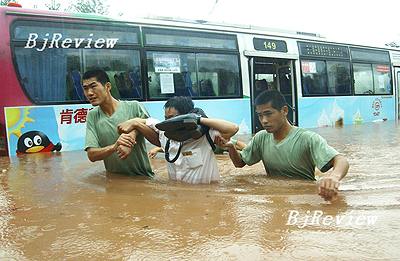
For half a month, twice each day, she swam across the river to Coral Dam Island to feed her four newborn babies, and then swam back to the bank to seek food for herself.
She was an abandoned female dog, the mother of four puppies, and considered a heroine by local people in Chongqing Municipality, which had suffered excessive rainfall and floods that blocked the road to Coral Dam Island.
The story is a touching one, but far more human tragedies were taking place across China this summer, as many parts of the country were plagued by fierce rainstorms, triggering floods, landslides and mud-rock flows.
Disasters caused by heavy rains killed at least 71 people in central China's Hubei Province, 42 in the mountainous Chongqing Municipality, 54 in Sichuan, 163 in Yunnan, 40 in Shandong and 38 in the far northwest Xinjiang Uygur Autonomous Region, according to the Ministry of Civil Affairs of China.
Though some parts of China have had too much rain, others had too little this summer, with long droughts, coupled with high temperatures, affecting 9.8 million hectares of crops in China, according to the State Flood Control and Drought Relief Headquarters.
Cheng Dianlong, Deputy Chief of the agency, said Heilongjiang Province, most of the Inner Mongolia Autonomous Region and many regions in south China have received 50 to 90 percent less rain since July than normal.
The drought has left 7.53 million people and 5.08 million head of livestock short of drinking water. It has also affected 44 percent of arable land in Jiangxi Province, 35 percent in Heilongjiang and 33 percent in Hunan.
The drought caused heavy losses to farm production as rice growing in the south and corn and soy production in the north were affected, according to Cheng.
Season of disasters
China's season of natural weather disasters did not end with the drought: other extreme weather conditions have also tortured the country.
On August 2 and 3, nine people were killed and almost 90,000 affected after windstorms ravaged east China's Anhui Province. The storms brought down 251 houses and damaged more than 2,000 others.
Five people were crushed to death when a two-story building collapsed after being struck by lightning in Linquan County, according to the provincial disaster relief office. Two other cities in the province each reported a death from lightning strikes.
According to China Meteorological Administration (CMA), lightning left 141 people dead in China in July, the highest monthly death toll since records began in 2000.
Song Lianchun, CMA Spokesman and head of the Disaster Forecast and Relief Department, said that this year China had been hit by increasingly frequent and severe lightning. The numbers of hailstorms and cyclones have also been rising.
Between the beginning of the year and June 30 various natural disasters across China had affected around 143 million people and resulted in 545 deaths, 78 missing and a total direct economic loss of 50 billion yuan, according to statistics produced by the Ministry of Civil Affairs .
Global warming
"It should be said that one of the reasons for the weather extremes this year has been unusual atmospheric circulation brought about by global warming," Song told a news conference carried live on the Central Government website on August 1.
"These kinds of extremes will become more frequent, and more obvious. This has already been borne out by the facts," he said. "I think the impact on our country will definitely be very large."
Chinese experts also attributed the country's extreme weather conditions to climate change.
The chief forecaster at CMA, Wang Yongguang, said abnormal weather would continue to plague most parts of China this summer and in the years to come.
Although the effects of global warming have become increasingly obvious in China this year statistics show that it has been a gradual process. The CMA said in early March that the winter season from December 2006 to February 2007 recorded a national average temperature of 2.4 degrees Centigrade below zero, causing China to experience its second warmest winter in 50 years, following the warmest winter in the country between 1998 and 1999, with an average temperature of 2.3 degrees Centigrade below zero.
China is certainly not the only victim of climate change. This summer Europe has been split by climate. Above a line roughly running from the Pyrenees to Bulgaria, three humid months have been punctuated by violent storms and enormous cloudbursts; while to the south there have been a succession of heatwaves, each more intense than the last. There have also been rare brutal snowstorms in South America and terrible floods in Southeast Asia, killing 1,400 and resulting in 20 million homeless.
"An abnormality of atmospheric circulation is the direct cause of these global weather extremes," said Ren Fumin, a researcher with the Climate Center of CMA. "But in essence, it is the global warming that has resulted in the abnormal weather conditions."
Joint efforts
Global warming effects have and will always vary for natural reasons. However, human activities are increasing significantly the concentrations of some gases in the atmosphere, such as greenhouse gases (GHG), which tend to warm the earth's surface.
"Global warming includes two aspects. On one hand, nature has its own course of climate change and on the other hand, human activity plays an important role regarding the warming trend,"
| 